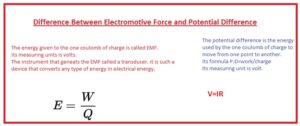 Hello, friends, I hope you all are doing great. In today’s tutorial, we will discuss the Difference Between Electromotive Force and Potential Difference. The potential difference and EMF are types of energy. The basic difference between emf and a potential difference is that emf is generated when any other form of energy is transformed in electrical energy while in potential difference electrical energy is transformed into the other type of energy.
Hello, friends, I hope you all are doing great. In today’s tutorial, we will discuss the Difference Between Electromotive Force and Potential Difference. The potential difference and EMF are types of energy. The basic difference between emf and a potential difference is that emf is generated when any other form of energy is transformed in electrical energy while in potential difference electrical energy is transformed into the other type of energy.
In today’s post we will have a detailed look at both emf and potential differences and compare them to find their differences. So let’s get started with the Difference Between Electromotive Force and Potential Difference.
Difference Between Electromotive Force and Potential Difference
EMF
- The energy given to the one coulomb of charge is called EMF.
- its measuring units is volts.
- The instrument that geneats the EMF is called a transducer. it is such a device that converts any type of energy in electrical energy.
- In case of having a close path created through conductive material then force applied on charges in the path to move on created emf.
- The instruments that have 2 terminals emf value can get from these points
- The electromotive generation devices examples are cell, battery solar, and photodiodes.
- Magntic fielld also generats emf.
- Its formula is ε=w/q
Potential Difference
- The potential difference is the energy used by the one coulomb of charge to move from one point to another.
- Its formula P.D=work/charge
- Its measuring unit is a volt.
- It is known as electric tension the work required to move the charges between two points is called the potential difference.
- Work done on per unit charge is called J/C in this equation volts is one joul work done one column charge.
- the potential difference among different terminals can be generated through the creation of charges and magnetic fields that are due to charge in motion
- A voltmeter can be used to find potential differences.
EMF vs Potential Difference
| Electromotive Force (E.M.F) |
Potential Difference
|
| It is a difference in the potential of battery electrodes |
It is the potential difference between two points of circuits
|
| E.M.F is larger than the potential |
always less than the E.M.F
|
| E = I(R + r) | V = IR |
| It is due to electric gravitational and magnetic fields. |
it is the result of the electric field.
|
| EMF is the amount of energy given to a coulomb of charge. |
It is the amount of energy used by one coulomb of charge.
|
| It is not based on the circuit’s internal resistance. |
It has a direct relation with the circuit’s resistance.
|
| It transfers energy across the circuit. |
The potential difference between two points of the circuit is a measure of energy.
|
| If the circuit is not charged value of the electromotive force is always higher than the potential difference. |
It circuit is charged, and the size of the potential difference is equal to the circuit’s emf.
|
| Electromotive force was measured with an emf meter. |
potential difference is measured with a voltmeter.
|
Read also:
- Difference Between Volt and Ampere
- Difference Between Volts & Watts
- Difference Between Shunt and Series Voltage Regulator
- Difference Between EMF vs Voltage
- Difference Between AC & DC Voltage
Faqs
- EMF is the voltage generated between two points of battery terminals and voltage is the potential difference between two electrode potentials of the battery
- EMF and cell potential are measured in units of volts EMF is a difference in the potential of two electrodes and there is NO current flow in the cell. The cell potential is the measurement different from the current flow
- Terminal voltage is the potential difference over terminals when the circuit is on. EMF is the maximum potential difference that a cell or generator has features to generate if no current flow about it
- It is measured in volts, the main difference is that it does not come with a remaining constant and is considered as outcome. It can be defined that each emf is a potential difference that is measured in an open circuit. So every emf is a potential difference.
- Emf is not force that is the potential difference, and it is defined in accurate terms EMF is the potential difference that is generated when not current passing.
- When current flows in the circuit, then there are voltage losses due to inner resistance. So V is less than E. It can also denoted by the equation V=E-Ir.
- EMF defines how much energy is provided to the circuit for moving one coulomb of charge across the circuit. Emf is larger than the potential difference between the two points. The potential difference is less thatn the maximum value of EMF when the battery is charged.
- EMF forces were defined by Alessandro Volta, who defines that there was force separating charges in current passing in a closed circuit. So this force is called EMF and the unit is volt.
So friends it is a detailed post about the difference between emf and potential difference. If you have any further queries ask in the comments. See you in the next post have a good day.






